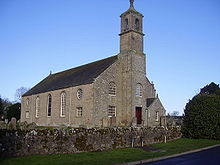Eccles, Scottish Borders

Eccles (
Etymology
Like other 'Eccles'-names in Britain, this is taken to derive from the Brittonic word which survives in Welsh as eglwys 'church'.[1] The word was originally borrowed into Brittonic from Latin ecclesia.
History
It is said that there was a Christian enclave at Eccles in the 6th century or possibly before. Watson gives the derivation as most likely from the Welsh (or
Regent Albany stayed at Eccles Priory in November 1522 during an unsuccessful siege of Wark Castle.[3] It was burnt by the Earl of Hertford's forces in 1545, then laicised to the Home family. Only two barrel-vaulted cells of the east range at the west end of the churchyard survive as well as architectural fragments built into later garden walls, although the parish church, rebuilt in 1774, may include some mediaeval stones.[4][5] Patrick I, Earl of Dunbar, who died on 31 December 1232, was interred in the convent at Eccles.
Lairds
The principal landed proprietors in the vicinity of Eccles in 1696 appears to have been George Home of Kames (which is situated towards Birgham) who had 9 hearths, Purves Hall, then occupied by Marjory Flemming, had twelve hearths, and Simon Marjoribanks of Stainrig who had six. (Purveshall and Stainrig are closer to Leithholm than Eccles).[6] In 1843 it was James Greig who resided at Eccles House, which abuts the village.[7]
Kirk
The
Today Eccles is conjoined with the parishes of Birgham and Leitholm.[13]
Notable residents
- Possibly the district's most famous son is Henry Home, Lord Kames.
- zoologist
- William Barron (1805-1891), landscape gardener and park designer, born here
- Thomas Creak Craik was a resident of both Eccles and Temple Village. He was one of the early modern farmers and owned Whitrig Farm, but the family also managed other properties. In 1832 Thomas funded the building of a New Church, in Temple Village.
In popular culture
The village was also mentioned in Wolfbloods Dark rune episode.
See also
Notes
- ^ Bethany Fox, 'The P-Celtic Place-Names of North-East England and South-East Scotland', The Heroic Age, 10 (2007), http://www.heroicage.org/issues/10/fox.html (appendix at http://www.heroicage.org/issues/10/fox-appendix.html).
- ^ Watson, W. J. (1926): History of the Celtic Place-Names of Scotland, Edinburgh: Edinburgh University Press
- ^ Ken Emond, The Minority of James V (Edinburgh, 2019), p. 175.
- ISBN 1-873190-10-7
- ^ Oman (1995) p.56 and 122
- ISBN 1-874232-01-0. p.2 - 7, 1696 Hearth Tax.
- ^ Findlay, James, Directory to Gentleman's Seats, Villages, &c., in Scotland, Edinburgh, 1843, p.52
- ^ Strang (1994) p.62
- ^ a b Ewan (1998) p.8
- ^ Genealogical Collections Concerning The Scottish House of Edgar, The Grampian Club, London, 1873, p.9
- Aberdeen UniversityPress, 1990.
- ^ Anderson, Rev. John, editor, Calendar of the Laing Charters, 854-1837, Edinburgh, 1899, page 716, number 3114.
- ^ Ewan (1998)
